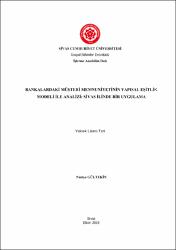Bankalardaki Müşteri Memnuniyetinin Yapısal Eşitlik Modeli İle Analizi: Sivas İlinde Bir Uygulama
Abstract
Bu araştırmanın amacı; yapısal eşitlik modellemesi ile bankaların müşteri
memnuniyetlerini belirleyebilecekleri bir ölçek geliştirmektir. Ayrıca müşteri
memnuniyeti faktörlerini belirlemek ve belirlenen bu faktörler ile bankalardaki
müşteri memnuniyetinin mevcut durumunun tespit edilerek banka müşterileri için
rehber olacak bir ölçek geliştirilmek istenmiştir. Bankalardaki müşteri
memnuniyetini etkileyen; “Fiziki Görünüm”, “Kuruma Bağlılık” ve “Yeterli
Güvence” “Heveslilik”, “Duyarlılık” “Güvenilirlik” şeklinde isimlendirilen 6 alt
faktörlü ölçek belirlenmiştir. 250 banka müşterisine 34 maddeden oluşan bir anket
uygulanmıştır. Elde edilen verilere SPSS 23 ve AMOS 23 paket programları
yardımıyla yapısal eşitlik modellemesi altında doğrulayıcı faktör analizi yapılmıştır.
Uyum indeksleri x²/sd 2,291<3, RMR 0,066<0,08, RMSEA 0,072<0,08 şeklinde
hesaplanmıştır. Doğrulayıcı faktör analizi ile oluşturulan modelin verilere uyum
gösterdiği belirlenmiştir. Doğrulayıcı faktör analizi ile geçerli uyumun var
olduğunun belirlenmesi, yapı geçerliliğinin sağlandığını göstermiştir. Ayrıca ölçeğin
güvenilirliği için Cronbach α değeri 0,940 bulunmuştur. Ayrıca bulunan faktörlerin
demografik verilere göre durumu t testi ve ANOVA incelenmiştir.
Çalışma neticesinde, müşteri memnuniyetini etkilediği düşünülen, “Fiziki
Görünüm”, “Kuruma Bağlılık” ve “Yeterli Güvence” faktörlerinin demografik
verilere (cinsiyet, yaş, medeni durumu, eğitim durumu, İş durumu, iş sahipliği, aylık
gelir düzeyi) göre anlamlı bir farklılık göstermediği gözlenmiştir. Ayrıca
“Duyarlılık” faktörünün yaş ve gelir, “Güvenilirlik” faktörünün cinsiyet,
“Heveslilik” faktörünün cinsiyet ve gelir durumuna göre anlamlı bir farklılık
gösterdiği sonucuna ulaşılmıştır. Ayrıca şahısların en fazla dikkate aldığı faktörlerin
“Heveslilik” ve “Duyarlılık” olduğu, bunu “Güvenilirlik” faktörü izlediği sonucuna
ulaşılmıştır. The purpose of this research; to develop a scale in which banks can determine
customer satisfaction through structural equation modeling. In addition, it was aimed
to determine the customer satisfaction factors and to develop a scale that will guide
the bank customers by determining the current status of customer satisfaction in the
banks with these factors. Affecting customer satisfaction in banks; 6 sub-factor
scales named “Physical Appearance”, “loyalty Commitment to Institution” and
“Adequate Assurance”, “Enthusiasm”, “Sensitivity” and “Reliability were
determined” A questionnaire consisting of 34 items was applied to 250 bank
customers. Confirmatory factor analysis was carried out using SPSS 23 and AMOS
23 software under structural equation modeling. The indices of fit were calculated as
x² / sd 2,291 <3, RMR 0,066 <0,08 and RMSEA 0,072 <0,08. The confirmatory
factor analysis model was found to be compatible with the data. Confirmatory factor
analysis showed that the validity of the construct was determined. In addition,
Cronbach's α value was found to be 0.940 for the reliability of the scale. In addition,
the t-test and ANOVA status of the factors were analyzed according to demographic
data.
As a result of the study, a significant difference between demographic data
(gender, age, marital status, education status, job status, job ownership, monthly
income level) of “Physical Outlook”, loyalty Commitment to Institution ”and“
Adequate Assurance ”factors which are thought to affect customer satisfaction It was
observed. In addition, it was concluded that “Sensitivity” factor showed a significant
difference according to age and income, “Reliability” factor according to gender and
“Enthusiasm” factor differed according to gender and income. In addition, it was
concluded that the factors that most people take into consideration are eves
Enthusiasm and Sensitivity, followed by “Reliability” factor.















